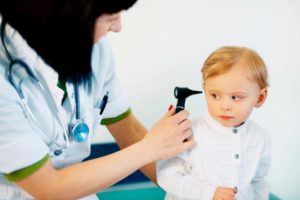 Children under 2 years old have a particularly high risk of middle-ear infections.
Children under 2 years old have a particularly high risk of middle-ear infections.
They affect an estimated 95 percent of kids at least once in their childhood.
In fact, an estimated 5 out of 6 American children will have an ear infection by the time they reach the age of 3.
This translates to 12-16 million clinical visits per year in the United States alone.
Middle-ear infections, also called otitis media, are the top reason that clinicians prescribe antibiotics to children.
Although a course of antibiotics is usually effective, it is not an ideal solution for a number of reasons. For instance, coercing a child into taking medication several times a day for 7-10 days can be challenging. As the senior author of the study, Dr. Daniel Kohane, colorfully explains:
“Force-feeding antibiotics to a toddler by mouth is like a full-contact martial art.”
The trouble with antibiotics and ear infections
Often, because the symptoms of an ear infection disappear before the course of antibiotics is over, parents stop treatment early; this means that ear infections are more likely to recur – 40 percent of children have four or more episodes.
Also, if a course of antibiotics is not taken in full, it encourages the development of drug-resistant infections, which is a growing concern for everyone.
Another issue with the current solution for treating middle-ear infections is that, because antibiotics do not easily travel to the site of the infection, high doses are necessary. And high doses bring an increase in side effects, including diarrhea, oral thrush, and rashes.
As Rong Yang, a chemical engineer in Kohane’s lab and first author of the paper, explains: “With oral antibiotics, you have to treat the entire body repeatedly just to get to the middle ear.”
Currently, this full-body approach is the standard treatment. Dr. Kohane and his team from the Laboratory for Biomaterials and Drug Delivery at Boston Children’s Hospital set out to design a solution to this age-old problem.
It may seem that squirting antibiotics into the ear canal might be an easier solution, but the eardrum, or tympanic membrane, is impenetrable. Dr. Kochane and his team have bioengineered a solution that could circumvent this anatomical gatekeeper.
“Our technology gets things across the eardrum that don’t usually get across, in sufficient quantity to be therapeutic.”
Dr. Daniel Kohane
His team has developed an antibiotic gel that can chaperone drugs past the eardrum and directly into the middle ear; it manages this with the help of chemical permeation enhancers (CPEs). These CPEs insert themselves into a membrane, opening molecular pores and allowing the antibiotics through.
Ear infections in chinchillas
To test the ability of CPEs, the researchers used a chinchilla model. Chinchillas are rodents with a similar ear structure and hearing range to humans.
The results were encouraging. The CPEs enabled large quantities of an antibiotic – ciproflaxin – to enter the middle ear and successfully treated 10 out of 10 animals. When ordinary ciproflaxin ear drops were used, only 5 of the 8 animals were cured within 7 days.
The approach seems to work, and there was no observable toxicity or antibiotic presence measured in the blood. One minor drawback was a reduction in hearing, similar to that caused by earwax. However, simply reducing the dose of gel relieved that particular issue.
“Transtympanic delivery of antibiotics to the middle ear has the potential to enable children to benefit from the rapid antibacterial activity of antimicrobial agents without systemic exposure and could reduce emergence of resistant microbes.”
Dr. Stephen Pelton, pediatric infectious disease physician and coauthor
Dr. Kohane recently won a large, 5-year grant from Boston Children’s Hospital’s Technology Development Fund. The money will be used to push the patented technology closer to clinical use.
In the future, a difficult-to-manage course of strong antibiotics may be replaced by a singular squirt of antibiotic gel directly into the ear.






